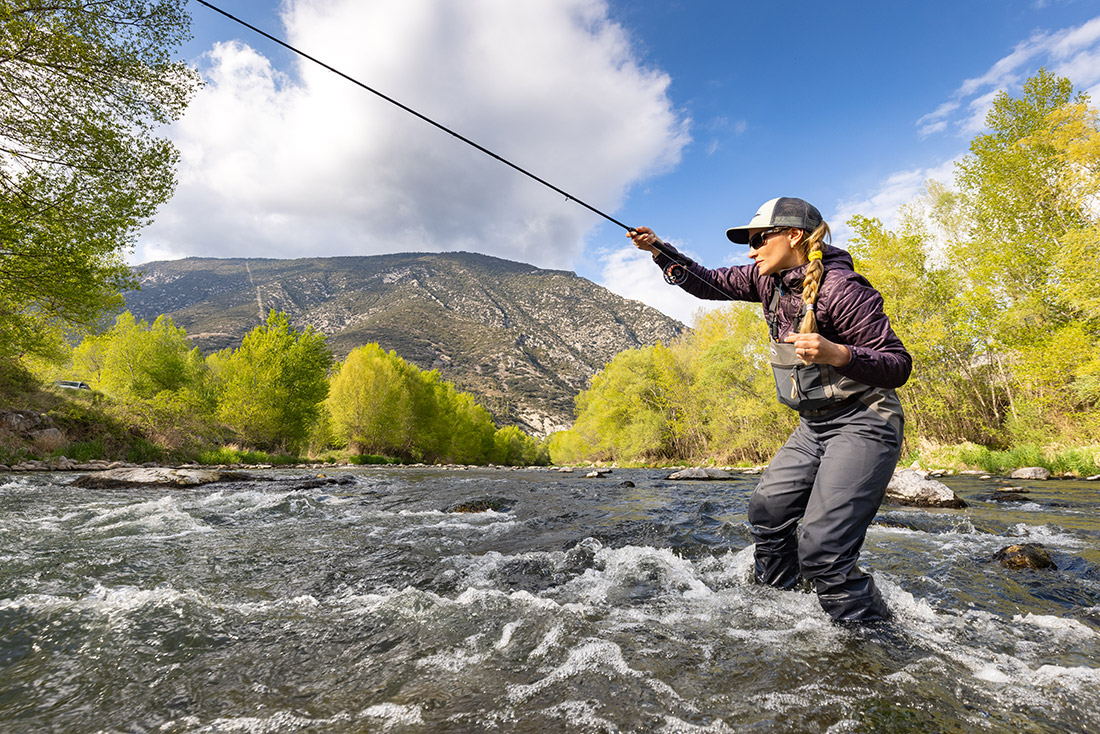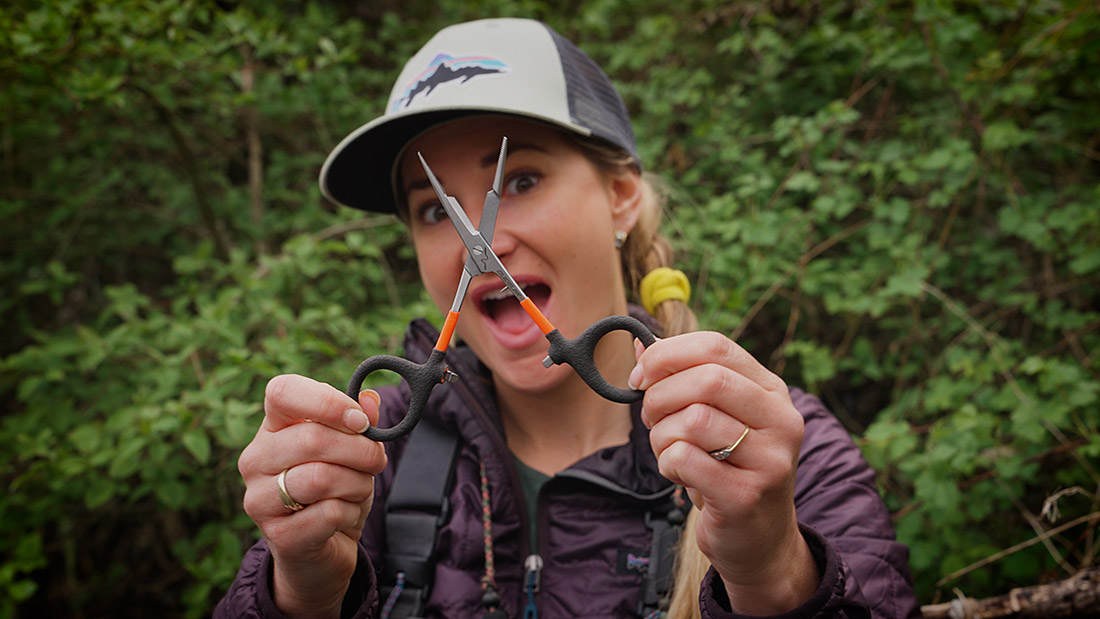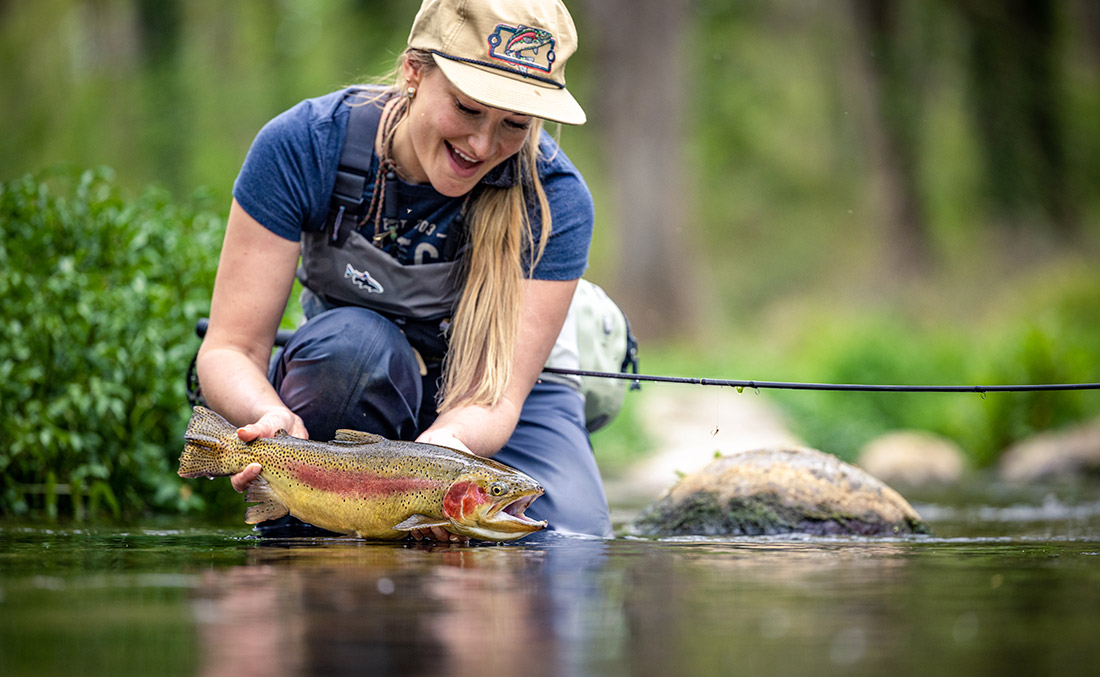What do I need besides rod, reel, line, and a few flies? Marina Gibson teaches fly fishing to countless beginners every year in her fishing school. And the question about the most important accessories is asked almost every time. To successfully fly fish, you don't need much! However, there are some important tools you shouldn't do without on the water to be prepared for all eventualities. In this video, Marina gives you the answer to this question and introduces you to her absolute essentials.
Getting started can be tough... Well, is it always? The vast range of products in fly fishing can quickly overwhelm a beginner. However, you don't need much to start off successfully and effectively on the water. A few essential tools, along with your rod, reel, line, and some appropriate fly patterns, can make your fishing experience much smoother. Marina is often confronted with this question: What gear do I need to buy for the beginning? There certainly are a myriad of practical tools that can be recommended to a beginner for starting in the new hobby, but the list can also be narrowed down to a few essentials. After all, the hobby should be fun primarily and not deterred by a price and material battle. That's why we have put together a small list of recommendations for you here. Especially if you, like Marina, enjoy lightweight fishing, you should focus on the most important tools.

Marina prefers to travel light. She keeps fly boxes and all essential tools close to her body.
Polarized Sunglasses
Polarized sunglasses provide essential eye protection against stray hooks that can often deviate from the intended flight path, especially for casting beginners. Most importantly, the polarizing filter in the lenses takes away the reflections on the water and allows us to see fish and underwater structures much better. This helps us not only locate fish but also observe them feeding or, ideally, even taking our fly. A suitable pair of polarized sunglasses in the right lens color should definitely not be missing from your initial equipment. To learn more about polarized sunglasses and which ones are suitable for you, check HERE.
Pliers or Forceps
An absolute must! There's no way around a tool for releasing flies deeply seated in a fish's mouth, as it's inevitable that fish will occasionally take the fly a bit deeper. With a good pair of forceps or long, thin pliers, you can gently and quickly remove the hook from the fish's throat. This is especially important if you don't intend to keep every fish you catch! We always recommend fishing with barbless flies; in some waters, it's even mandatory. However, if you only have flies with barbs in your box, you can easily press the barb down with good pliers, turning it into a barbless hook. This makes setting the hook even easier and, of course, removal much simpler and gentler. Many multi-function pliers even have small built-in scissors and a pointy needle for clearing blocked hook eyes.

With this, Marina has combined all three things in one multi-tool: pliers, scissors, and a needle for clearing blocked hook eyes.
Nipper
If you want to be successful, you should try out and experiement a lot: a different fly, a longer leader, or perhaps a thinner tippet... A nipper will greatly simplify your life in this regard, as it is the perfect tool for cutting leader materials. Whether it's monofilament or fluorocarbon, with a quick snip, the material is quickly and precisely shortened, or knots and tag ends are removed close to the hook eye.
Rubberized Landing Net
A landing net is essential for quickly and safely landing your fish. Most fish are lost just before landing, and delaying this moment will result in losing more fish sooner or later. And do yourself a favor: use a rubberized catch-and-release net! Whether you want to release the fish or not, you never know if a fish is undersized or if you catch an unintended species. The rubberized netting protects the sensitive skin of the fish and preserves their fins. Additionally, the material dries quickly and prevents unpleasant odors. We prefer using a net magnet with a safety leash to attach our nets to our backs. Safe and always within quick reach! If you want to learn more about rubberized nets, take a look HERE.
Lanyard or Retractor
When you suddenly spot a feeding fish, things can get chaotic quickly. In such moments, it's especially helpful to have your most important tools right on your person and not have to search for your nipper or floatant. A lanyard solves this problem. These practical necklaces provide enough space (in the form of clips and hooks) for all your essential accessories that you need to have at hand at all times. Especially if you're fishing without a vest, wading jacket, or waders with appropriate attachment options, such a practical helper can make your life much easier.
Monomaster
As fly angler, we always have an obligation to treat nature with respect and leave the waters in their most natural state. During re-rigging, fly changes, etc., leader waste is constantly generated, which should be disposed of properly. At home! The Monomaster provides a solution, as the small velcro roll inside swiftly collects your mono and fluorocarbon waste, storing it until you can dispose of it conveniently at home.
Tippet Spool Holder
All your essential tippet diameters neatly sorted side by side and at a glance. This way, you never have to rummage unnecessarily in your pockets when you want to extend your leader or change your rig. Most tippet spool holders have enough space for all the spools you need for a changeable day on the water. And if you want to save even more time during rigging, use a spool holder with a built-in cutter.
Floatant
If you enjoy fishing with dry flies, you'll quickly realize that they float well, but not always for long. To extend the buoyancy of your dry flies or to restore it after a dunk (or a fish), there are various floatants available on the market. Depending on the material and tying style of the dry fly, different floatants are recommended. Gel or oil, for example, for flies that are still dry, "liquid floatant" to restore buoyancy to wet flies, or in powder form (optionally with a brush) to treat delicate CDC feathers. Naturally, at the beginning, you don't need three different products. Most gels or oils with explicit CDC labeling are perfectly suited for all flies and most situations. And here's a little tip from Marina: Take a thick rubber band and attach it to your lanyard (or similar). With this, you can quickly remove excess water from your wet dry flies with a few quick "flicks." We also never stop learning ;).
We hope that this short list and the video with Marina simplify your entry into fly fishing and help you navigate the dense forest of products out there. Below, you will find our favorite products from all categories once again, so you don't have to click your way through the shop. If you still have questions, feel free to reach out through the relevant channels (Instagram, Facebook, via email), or call us. We're happy to help!
If you're still unsure about choosing flies, Marina also provides some tips. Check out her article here.


 adh-world
adh-world
























